Results 1,051 to 1,080 of 1480
-
2018-05-31, 04:17 AM (ISO 8601)Banned


- Join Date
- Mar 2018
- Location
- The Moral Low Ground
-
2018-05-31, 04:46 AM (ISO 8601)Ogre in the Playground


- Join Date
- Aug 2013
 Re: Got a Real-World Weapon, Armor or Tactics Question? Mk. XXV
Re: Got a Real-World Weapon, Armor or Tactics Question? Mk. XXV
Last edited by snowblizz; 2018-05-31 at 04:47 AM.
-
2018-05-31, 05:22 AM (ISO 8601)Ogre in the Playground


- Join Date
- Aug 2013
 Re: Got a Real-World Weapon, Armor or Tactics Question? Mk. XXV
Re: Got a Real-World Weapon, Armor or Tactics Question? Mk. XXV
Why would it be unheard of when Medieaval Europe would still remember Imperial Rome? Not to mention how the Catholic church retained many of it's trappings, not in the least the purple robes of bishops.
Bright blue pigment for paints were rare, blue dyes are much easier to make.
There is however a grain of truth to the rairty of blue. It's a fact that nature itself has few blue pigments occuring naturally. I saw a documentary about it showing how most blue things in nature are a property of fragmenting lightwaves and not an actual pigment. IIRC there are precious few animals you could get a blue pigment off if you tried. They showed this enormously brigt blue butterfly that turned grey id dipped in alcohol and thne as it dried turn blue again. Fascianting stuff.
One of the major issues with colouring was to make the colour stick. I think that's part of the "pastel peasants" which am not entirely sure if G is joking about or not.
There's an intersting youtube video answering the question why so few flags have purple in them and the answer basically boiled down to when the national colours were largely adopted the expense of needing so much purple was prohibitive.
I was watching a show about rebuilding a medieval French castle and the British historians there (because obvisouly) this episode dyed cloth blue and mentioned the French propensity for blue and that it was adopted as a royal colour. The fun part is that France was the biggest producer of woad it seems. But even then it wasn't exactly cheap or commonly available as you have to farm it on an almost industrial scale, I think they said 1-2kgs from a hectare or something after the complex process (there were quite a few steps, most labour intensive) to render down the plant into a usable dye.
I also wanted to point out that there's a difference in dye and colours. E.g. clothing and paintings can't use the same thing to produce colours, blue was indeed very expensive as a paint for pictures as the best and brightest was ground semi-precious stones. But that cannot be used to dye clothes. Liekwise the owad used for textiles as I understand isn't very good for paintings. So basically blue can both be extremely expensive and rare while much cheaper and commonly available at the same time, just for different applications.
The other thing to point out is that it's one thing to dye/colour stuff, another to get to stick around. For paintings you need to mix colours with a medium which means they need to be rather brilliant as somehting will be lost in the paint. Clothes on the otherhand need to be able to soak in the colour and get it fixed. In both cases the colours risk degrading as chemicals are broken down, amongst others from sunlight. That last problem persists even to this day (though we've done much to improve on it anturally). Got plenty of clothes with faded colours.
The existence of bright fabrics notwithstanding, getting the right colour and making it stick was a general problem right up to the advent of synthetic dyes. The famous British Redcoats didn't always quite live up to their name for example, much to the annoyance contemporaries (outsourcing has always produced interesting results).
-
2018-05-31, 07:28 AM (ISO 8601)Dwarf in the Playground


- Join Date
- May 2018
 Re: Got a Real-World Weapon, Armor or Tactics Question? Mk. XXV
Re: Got a Real-World Weapon, Armor or Tactics Question? Mk. XXV
I enjoyed your post and you are right to point out the difference but it seems that blue clothes were also fairly rare before the XIII century.
They are sources for example about the «*garance*» producer of Strasbourg (a Kind of red) and their techniques seem advanced but the same cannot be said about blue. But in a few decades, from 1180 to 1260, the technics and use of blue change rapidly to the point that the producer of red start complaining about the loss of money and prestige.
In Rome and Greece, blue was considered barbaric. Blue eyes for example were ridiculed for a man and the sign of a depraved woman. Blue clothes were unheard of, till the Late Empire.
It is also hard to say blue in latin or greek. In Roman language (french, Italien etc.) the word came from germanic rooots, blau, or from arabic, azur.
Blue was not a liturgical color, and is still not to this day. This is a major point because the christianity was a huge factor in medieval culture. In early medieval time, blue was commonly used as a pejorative color, a lot of devils were blue on manuscripts or in the statues of the churches.
It is also worth considering that early coat of Arms were rarelly blue. For comparison in the XVIII century it was the most used color in heraldic.
So for a long time blue was to ill considered to be used on clothes or in art. But i have not the time yet to go ans further. If you are interrested i will come back with more later.
-
2018-05-31, 09:57 AM (ISO 8601)Banned


- Join Date
- Mar 2018
- Location
- The Moral Low Ground
 Re: Got a Real-World Weapon, Armor or Tactics Question? Mk. XXV
Re: Got a Real-World Weapon, Armor or Tactics Question? Mk. XXV
What's the economics of this? Like how much can 1-2kgs of woad dye?
An acre was "an amount of land plowable by one plow and it's ox" and a modern hectare is 2.4 "modern" acres (an Acre in sensible units is around 4000m2). Woad seems like it could be a pain to raise but I don't have a great farming knowledge and I kind of assume everything'd be a pain to raise. The grinding, balls and fermenting/drying seem more waiting than laborious (though one unreliable source said it permanently blackened hands)
The balls are noted to be a valuable trade good, but I don't know what that's relative to. Could a twelfth century peasant afford blue?
How often were medieval clothes made anyways? People didn't wear much, perhaps what they did wear was something they paid more attention to?
-
2018-05-31, 10:29 AM (ISO 8601)Bugbear in the Playground


- Join Date
- Feb 2015
 Re: Got a Real-World Weapon, Armor or Tactics Question? Mk. XXV
Re: Got a Real-World Weapon, Armor or Tactics Question? Mk. XXV
From my one attempt at it, I can say that woad is not hard to grow. Also, Wikipedia says it is listed as an invasive weed in several states of the American west.
-
2018-05-31, 12:14 PM (ISO 8601)Banned


- Join Date
- Mar 2018
- Location
- The Moral Low Ground
 Re: Got a Real-World Weapon, Armor or Tactics Question? Mk. XXV
Re: Got a Real-World Weapon, Armor or Tactics Question? Mk. XXV
http://www.woad.org.uk/index.html
I ended up finding this site pretty helpful in the economics of production(and it's reasonably referenced) and another I found somewhere that listed the profession of dye quite common. Do wish it was a bit more helpful with trade.Last edited by The Jack; 2018-05-31 at 12:15 PM.
-
2018-05-31, 02:09 PM (ISO 8601)Ogre in the Playground


- Join Date
- Nov 2012
- Gender

 Re: Got a Real-World Weapon, Armor or Tactics Question? Mk. XXV
Re: Got a Real-World Weapon, Armor or Tactics Question? Mk. XXV
The point is, while blue dyes were easily available, they weren't bright, but dark and/or greyish. Woad blue is like this:
Spoiler: Woad
Indigo is like this (indigo was imported from the Mediterranean, Africa or Asia):
Spoiler: Indigo


Most people in the Middle Ages favoured bright, light, warm, cheery colours if they could afford it, so they prefered reds, yellows and greens over blues. Blue was perceived as too cold and dark.
You could get a very bright, intense shade of blue using crushed turquoises, but it was too expensive.
However, around the XIII century they got the hang of creating affordable bright blue dyes in France, and french royalty, starting with king Louis IX, made it into their colour of choice (starting the "Blue Prince" or "Prince in Blue" trope).Last edited by Clistenes; 2018-05-31 at 02:17 PM.
-
2018-05-31, 03:20 PM (ISO 8601)Dwarf in the Playground


- Join Date
- May 2007
- Location
- Northern Ohio
- Gender

 Re: Got a Real-World Weapon, Armor or Tactics Question? Mk. XXV
Re: Got a Real-World Weapon, Armor or Tactics Question? Mk. XXV
-
2018-05-31, 04:26 PM (ISO 8601)Banned


- Join Date
- Mar 2018
- Location
- The Moral Low Ground
-
2018-05-31, 05:00 PM (ISO 8601)Firbolg in the Playground


- Join Date
- Nov 2009
- Gender

 Re: Got a Real-World Weapon, Armor or Tactics Question? Mk. XXV
Re: Got a Real-World Weapon, Armor or Tactics Question? Mk. XXV
While we are at it, there could also be local variations of great importance. For example, the minerals in the water in Hierapolis in Phrygia would fixate certain pigments, that otherwise would have faded with washing. It still was an important center in the times of Justinian.
 Originally Posted by J.R.R. Tolkien, 1955
Originally Posted by J.R.R. Tolkien, 1955
-
2018-05-31, 05:19 PM (ISO 8601)Dwarf in the Playground


- Join Date
- Sep 2017
 Re: Got a Real-World Weapon, Armor or Tactics Question? Mk. XXV
Re: Got a Real-World Weapon, Armor or Tactics Question? Mk. XXV
Well, I meant unheard of to actual know somebody with it- there is a reason purple is associated with Emperors. I probably should've said legendary or something. Tyrian purple at least was ridiculously expensive to produce, and most people probably didn't come accross it much if at all. The numbers of murex snails needed to make enough to dye a single cloak is enormous.
However, as pointed out to me, other purples most likely existed by simply mixing red and blue.Last edited by Haighus; 2018-05-31 at 05:20 PM.
-
2018-05-31, 06:30 PM (ISO 8601)Ogre in the Playground

- Join Date
- Oct 2009
- Gender

 Re: Got a Real-World Weapon, Armor or Tactics Question? Mk. XXV
Re: Got a Real-World Weapon, Armor or Tactics Question? Mk. XXV
If colors were rare in the day of Louis IX, I really can't say. By the time you are in the era of plate armor and longswords as I previously stated, you could find textiles of every color in the rainbow (and then some) in the market place of basically any large town.
The only real issues are related to quality. More rare colors might cost a little more, a good black was I think the most expensive in much of the 15th Century. But that had to do with the quality of the manufacturing of the textile and how the dying was done, which in turn had to do with things like the availability of alum, which was used for fixing dyes (and also tanning leather and other hides). A lot of rather vicious wars were fought, people were assassinated and so on over control of alum mines.
In most towns you would find the dyers shops near taverns, as people would pee in the dyers kettles that we were left out - the cheaper way to fix dyes was with urine.
But by the time of plate armor and so on, you really couldn't impress anybody with a color, per se. You needed to have really nice patterns, pretty designs, geometric or natural... stripes or checkers or swirls. Cloth of gold, silk, velvet. All kinds of embellishment. Try to banish the dismal costumes of Genre fiction, TV shows and games from your minds. Far from being less colorful and picturesque, actual medieval Europe was far more startlingly vibrant than really any of us can imagine today.


My theory of leading a horse to water having failed, I'm posting some links to images from Mathaus Schwarz famous book. This guy was an accountant for a rich man, but he himself was wealthy by no means unusually so. It will give you an idea what a professional could afford to wear in the late 15th and early 16th Centuries. I believe you'll also see him wearing purple outfits in some of the plates.
"Let those who have eyes to see, see"
Spoiler: Mathaus Schwarz




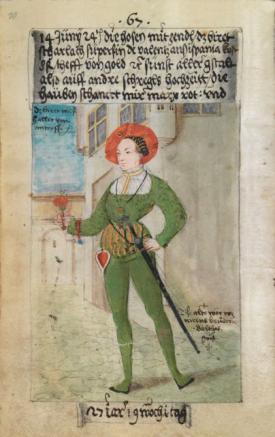









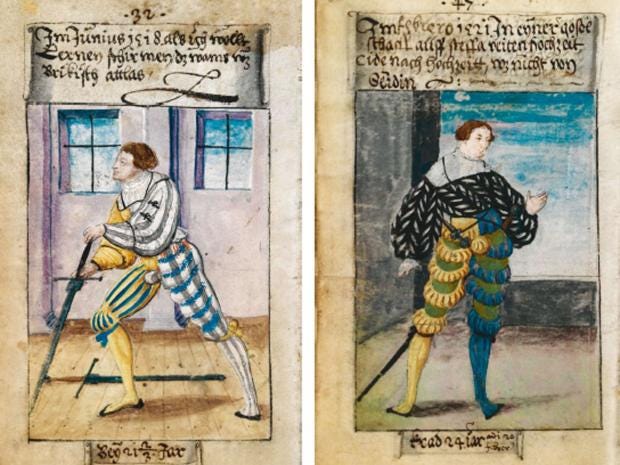
As just one other example, consider the colors (and patterns) of Carnival (Nuremberg Schembartlauf) costumes from the 15th Century. These are not the finest clothing or textiles available to the people in question, these are what they were using to make carnival costumes for one night of wild partying. I.e. if not throw away these are essentially once a year use.
P.S. the artichoke looking things most of them are carrying are fireworks kind of like sparklers used to light the way and keep crowds at bay
Spoiler: Nuremberg Carnival costumes 15th Century


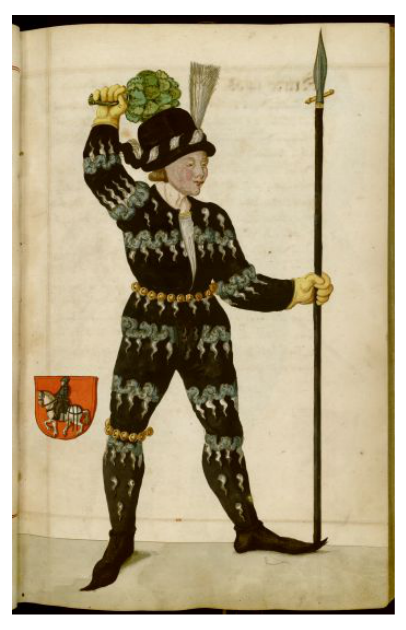
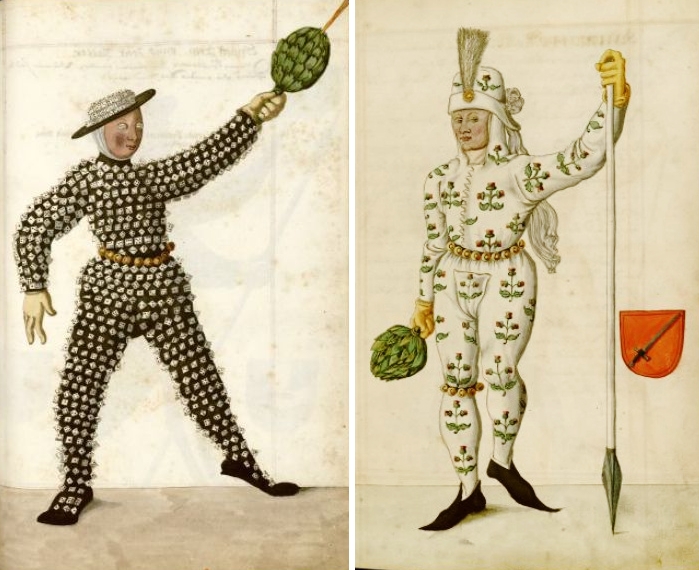


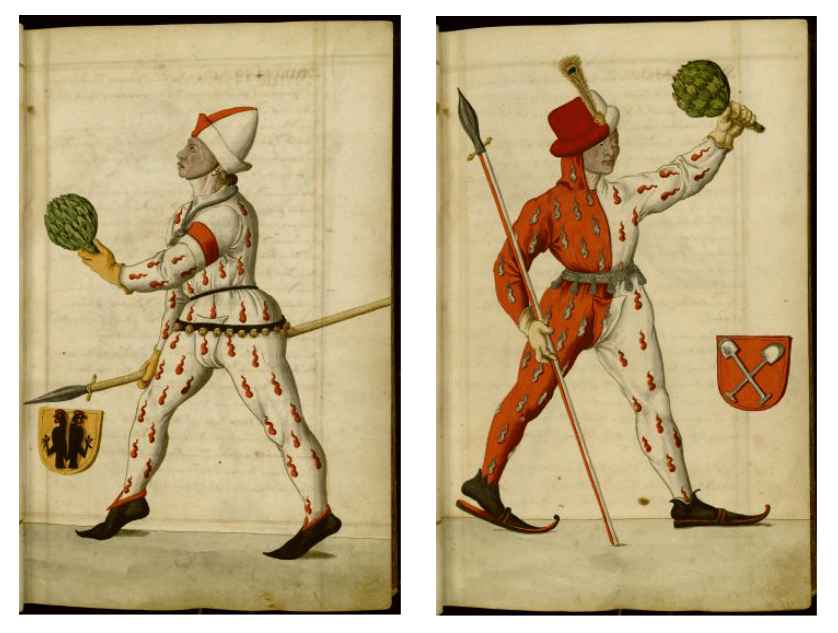
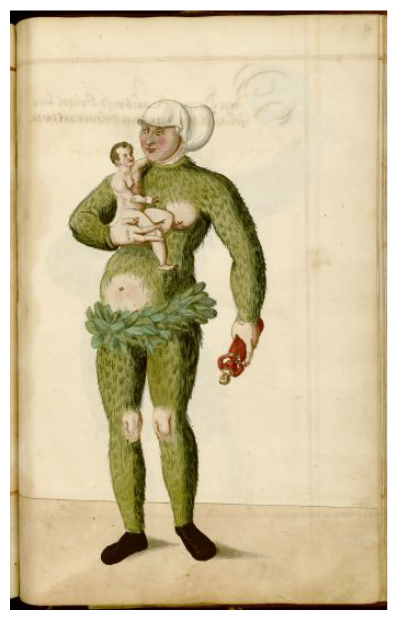


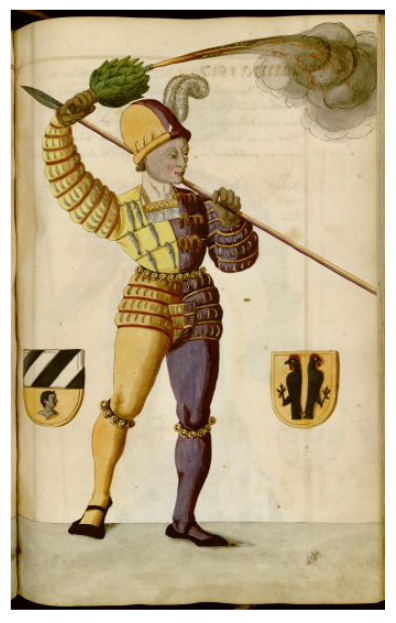








Again, some of you will understand the implications of these images and some of you obviously won't. I did already give you search terms you can use to find academic articles and books to use for references.
GLast edited by Galloglaich; 2018-05-31 at 06:36 PM.
-
2018-05-31, 06:34 PM (ISO 8601)Ogre in the Playground

- Join Date
- Oct 2009
- Gender

 Re: Got a Real-World Weapon, Armor or Tactics Question? Mk. XXV
Re: Got a Real-World Weapon, Armor or Tactics Question? Mk. XXV
You know it bears thinking about... we did something similar with the Classical World. We assumed it was all black and white. Actually makes the statues more elegant. But the real ones were apparently extremely colorful, even gaudy. Most people can't get their head around it, I know I had trouble.
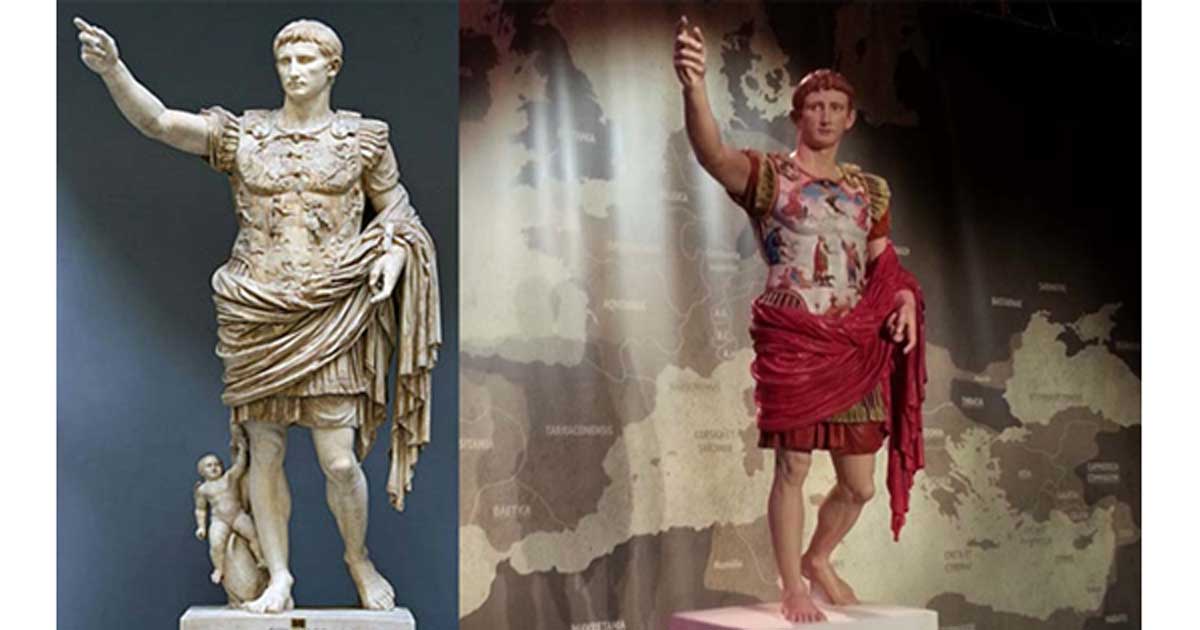
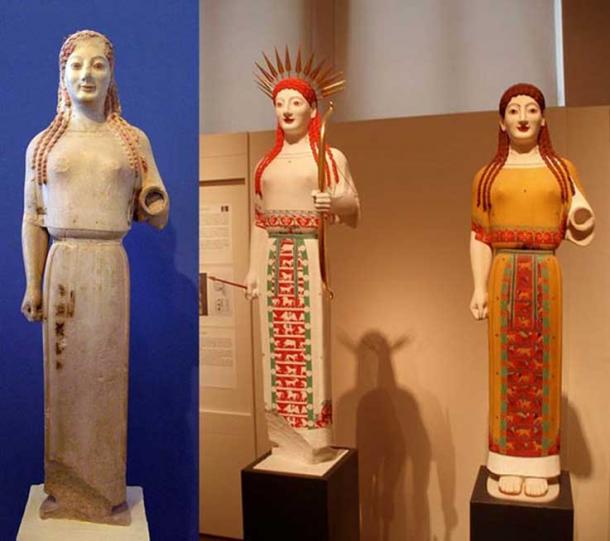

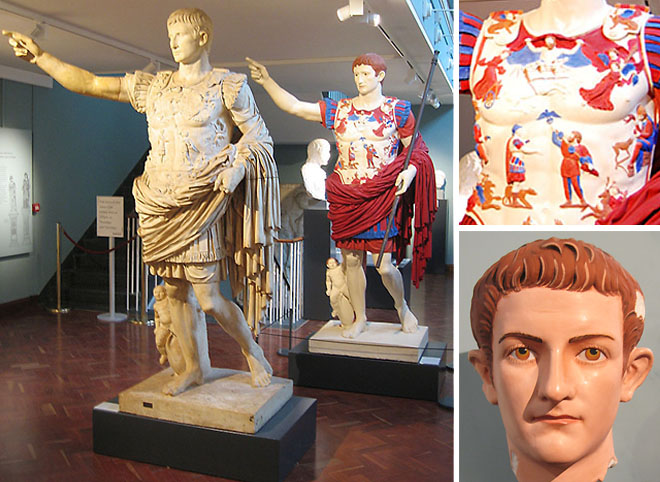
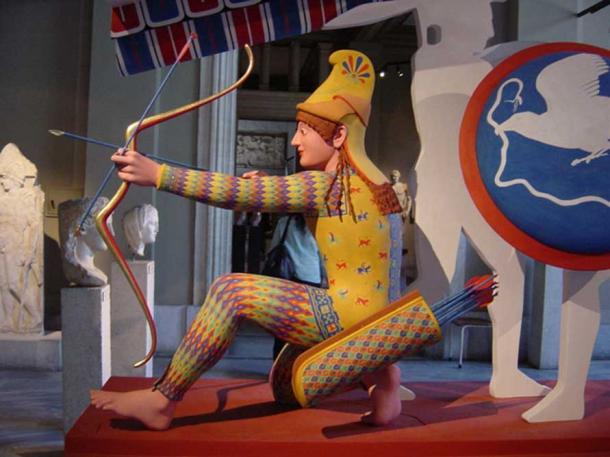
I guess the past just makes more sense if it's simpler.
-
2018-05-31, 06:35 PM (ISO 8601)Titan in the Playground


- Join Date
- May 2016
- Location
- Corvallis, OR
- Gender

 Re: Got a Real-World Weapon, Armor or Tactics Question? Mk. XXV
Re: Got a Real-World Weapon, Armor or Tactics Question? Mk. XXV
One odd thing in those pictures is the exposed breasts and knees in a couple of the more animal like costumes.
I guess fashion has always been strange...Dawn of Hope: a 5e setting. http://wiki.admiralbenbo.org
Rogue Equivalent Damage calculator, now prettier and more configurable!
5e Monster Data Sheet--vital statistics for all 693 MM, Volo's, and now MToF monsters: Updated!
NIH system 5e fork, very much WIP. Base github repo.
NIH System PDF Up to date main-branch build version.
-
2018-05-31, 06:39 PM (ISO 8601)Ogre in the Playground


- Join Date
- Nov 2012
- Gender

 Re: Got a Real-World Weapon, Armor or Tactics Question? Mk. XXV
Re: Got a Real-World Weapon, Armor or Tactics Question? Mk. XXV
Both versions were probably true, to some extent... Europe is big, the Middle Ages were a long period, and different social classes could afford different stuff... plus the already mentioned Suntuary Laws would limit some people in what they could wear...
But yeah, at least high classes in Western Europe dressed in what we would consider too strident or garish colours during most of the Middle Ages, and low classes would do too, if allowed and if they could afford it...
-
2018-05-31, 06:42 PM (ISO 8601)Ogre in the Playground

- Join Date
- Oct 2009
- Gender

 Re: Got a Real-World Weapon, Armor or Tactics Question? Mk. XXV
Re: Got a Real-World Weapon, Armor or Tactics Question? Mk. XXV
That is one of the big changes from medieval to Early Modern. Medieval people had far less prohibitions against or aversion to nudity. They all took baths together in public for one thing.
After ~ 1500 AD you have the onset of Syphilis, and probably not coincidentally, some new religious interpretations which denounce sex, nudity, and women. By around 1550 attitudes had changed a lot. By 1650 it's very strict, almost Victorian.
Some medieval cultural traditions related to body image seem odd though - in Medieval Germany a married woman with her hair down / uncovered in public was considered a bit shocking. You could see her in the bath stark naked, but her hair would be covered. But on the other hand a "Maiden" with her hair uncovered wasn't a big deal.
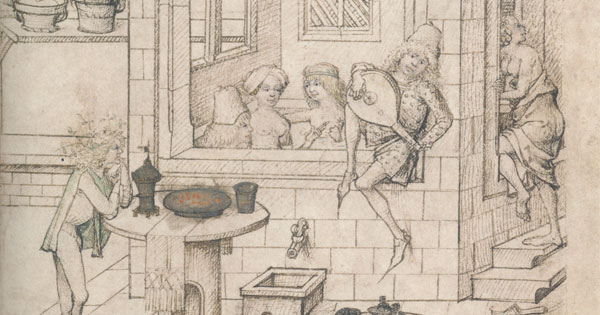
G
-
2018-05-31, 07:01 PM (ISO 8601)Titan in the Playground


- Join Date
- May 2016
- Location
- Corvallis, OR
- Gender

 Re: Got a Real-World Weapon, Armor or Tactics Question? Mk. XXV
Re: Got a Real-World Weapon, Armor or Tactics Question? Mk. XXV
It wasn't even that they were bare, but that they'd cover everything else elaborately and leave those parts bare. Like the green leafy one near the end of the carnival pictures.
But thanks for the info--I'm working on clothing styles for my setting and it's always interesting to see the variety of things that people did.Last edited by PhoenixPhyre; 2018-05-31 at 07:02 PM.
-
2018-05-31, 07:02 PM (ISO 8601)Ogre in the Playground

- Join Date
- Oct 2009
- Gender

 Re: Got a Real-World Weapon, Armor or Tactics Question? Mk. XXV
Re: Got a Real-World Weapon, Armor or Tactics Question? Mk. XXV
To be clear, all of the people in the images I posted were commoners. Schwarz was a professional, so basically upper middle class by todays standards (lets say he listens to NPR) but a lot of the others would be just basic burghers, even servants, peasants, day laborers and apprentices. Working class or middle class.
A basic middle class artisan might look like this self portrait of Flemish painter Robert Campin and the accompanying painting of his wife. Simple attire but hardly drab.


Upper middle class burghers might dress something like this 15th Century Flemish (Petrus Christus) depiction of St. Eligius (as a goldsmith) and two of his customers.
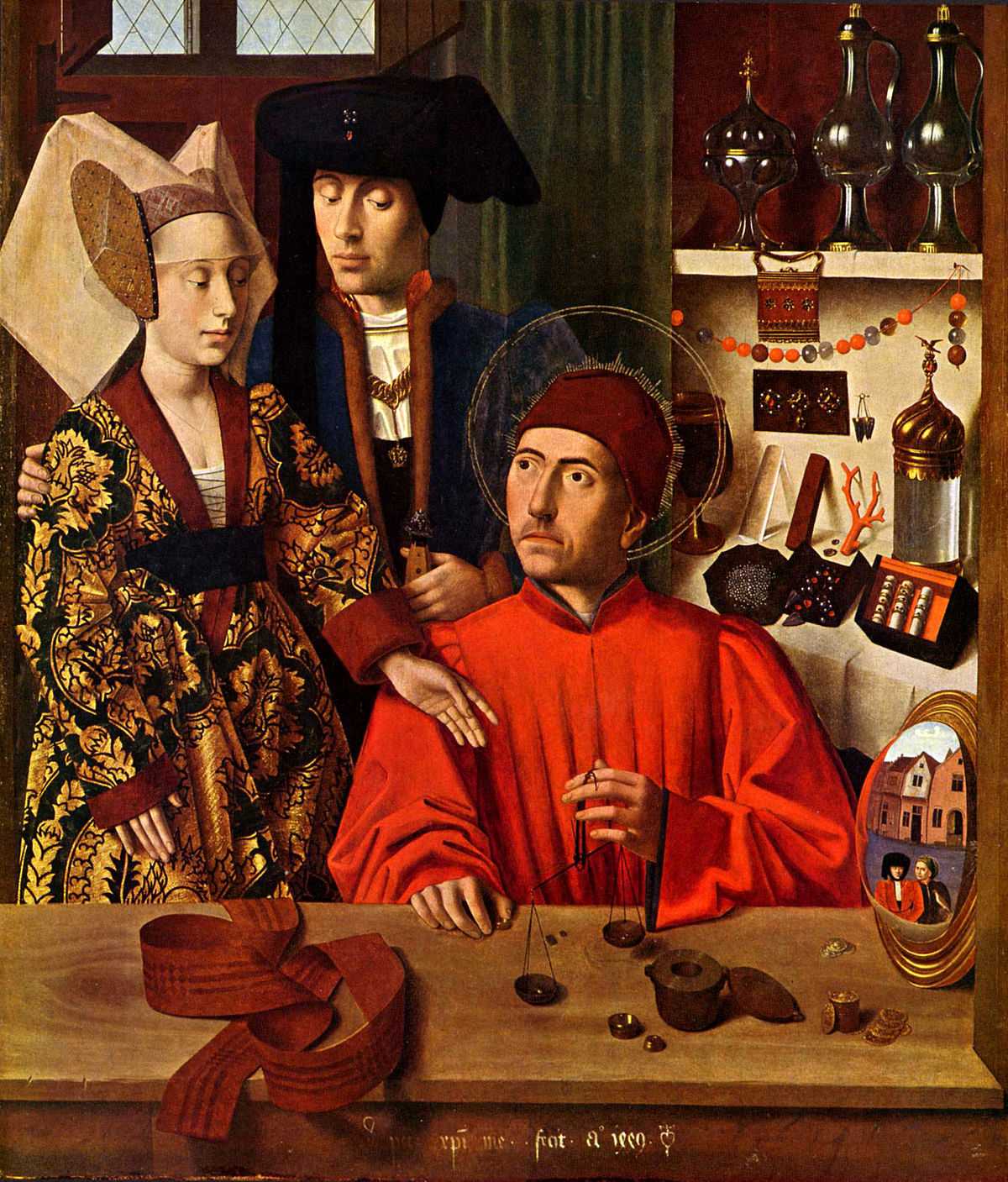
The wealthier urban classes tended to dress with gold and very expensive furs like this:


It also tends to be a bit more severe looking.
Whereas princes, the top level nobles, dressed in truly exotic garb

Margrave Casimir of Brandenburg, 1511

Duke Heinrich "The Peaceful" of Mecklenburg 1514
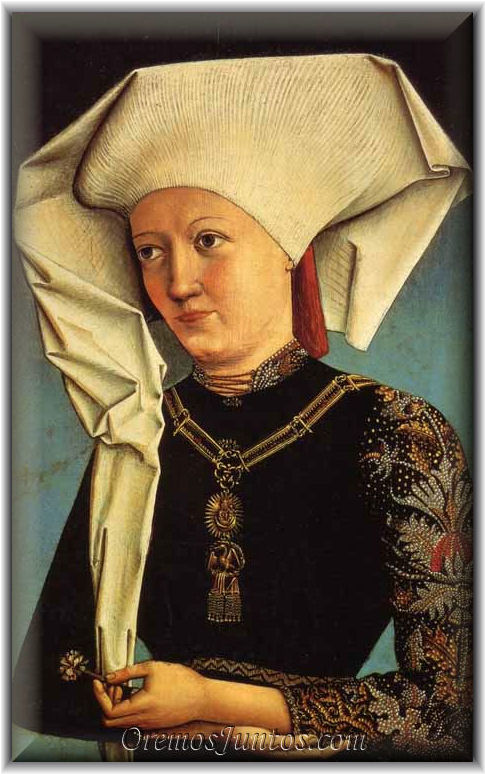
German noblewoman from 1490 (as St. Hemma von Gurk)
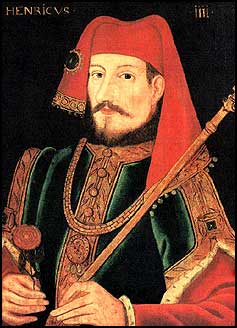
Henry IV

...and of course, the King of fashion, Philip "The Good" of Burgundy, 15th C
G
-
2018-05-31, 07:04 PM (ISO 8601)Ogre in the Playground

- Join Date
- Oct 2009
- Gender

 Re: Got a Real-World Weapon, Armor or Tactics Question? Mk. XXV
Re: Got a Real-World Weapon, Armor or Tactics Question? Mk. XXV
I'm from New Orleans and we still have Carnival, and I can tell you that on Mardi Gras day ladies often dress in such a manner as to emphasize maybe not their knees, but other parts of the anatomy.
Especially when you have a mask on and can be semi-anonymous, you might be surprised how people will dress. I doubt Carnival has changed that much even since the ancient Saturnalia and before.
G
-
2018-05-31, 07:07 PM (ISO 8601)Ogre in the Playground

- Join Date
- Oct 2009
- Gender

-
2018-05-31, 07:09 PM (ISO 8601)Titan in the Playground


- Join Date
- May 2016
- Location
- Corvallis, OR
- Gender

 Re: Got a Real-World Weapon, Armor or Tactics Question? Mk. XXV
Dawn of Hope: a 5e setting. http://wiki.admiralbenbo.org
Re: Got a Real-World Weapon, Armor or Tactics Question? Mk. XXV
Dawn of Hope: a 5e setting. http://wiki.admiralbenbo.org
Rogue Equivalent Damage calculator, now prettier and more configurable!
5e Monster Data Sheet--vital statistics for all 693 MM, Volo's, and now MToF monsters: Updated!
NIH system 5e fork, very much WIP. Base github repo.
NIH System PDF Up to date main-branch build version.
-
2018-05-31, 07:16 PM (ISO 8601)Ogre in the Playground

- Join Date
- Oct 2009
- Gender

 Re: Got a Real-World Weapon, Armor or Tactics Question? Mk. XXV
Re: Got a Real-World Weapon, Armor or Tactics Question? Mk. XXV
One other comment. I don't want to convey too 'Technicolor' of an impression. Schwarz is obviously showing off his nicest clothes in most of those paintings. He obviously has a lot of nice clothes, but i doubt he dressed like that every single day.
Similarly those Carnival costumes are obviously meant to be startling and jarring - that's the nature of Carnival.
I just wanted to show you what people could afford back in the 1300s, 1400s or 1500s, since that was the original question. Daily attire would probably not be so bright and colorful, but it wouldn't be hopelessly drab either. For towns, probably something like you see in depictions of daily life like you see here.


For rural peasants probably more like this famous Pieter Brughel painting. Much simpler than urban people but still not drab or crude looking like the "medieval caveman" on TV.

G
-
2018-05-31, 07:40 PM (ISO 8601)Titan in the Playground


- Join Date
- May 2016
- Location
- The Lakes
 Re: Got a Real-World Weapon, Armor or Tactics Question? Mk. XXV
Re: Got a Real-World Weapon, Armor or Tactics Question? Mk. XXV
The past is a foreign country.
But I'm loving this, need to package up all the info and sources, and send it off to a friend of mine who believes the "Dung Ages" / "Medieval Caveman" trope is "deeply realistic".It is one thing to suspend your disbelief. It is another thing entirely to hang it by the neck until dead.
Verisimilitude -- n, the appearance or semblance of truth, likelihood, or probability.
The concern is not realism in speculative fiction, but rather the sense that a setting or story could be real, fostered by internal consistency and coherence.
The Worldbuilding Forum -- where realities are born.
-
2018-05-31, 07:45 PM (ISO 8601)Dwarf in the Playground


- Join Date
- May 2018
 Re: Got a Real-World Weapon, Armor or Tactics Question? Mk. XXV
Re: Got a Real-World Weapon, Armor or Tactics Question? Mk. XXV
Actually blue was considered a warm color in medieval time. The representation of color was really different, for example green and yellow were seen as one of the strongest contrast and frequently used together to depict madness.
One cannot use our actual classification of colors, coming mainly from the discovery of the laws of optic in the XVIII century to explain the medieval understanding.
And it was actually the other way around in this case: the symbolic use of blue in art, theology and by the King of France lead to better technics and a groving industry of woad. Some cities, like Toulouse, were specialized in this new industry.
And i must disagree on a minor point with Galloglaich. From where i come ( Central Europe) Carnaval can have very traditionnal aspects, and are mainly organised by companies. The costumes of those companies are often more expensive than everiday clothes. You could Check for example the carnaval of Basel.
Carnaval was often a scenography of the power of the City with huge display of wealth and power. Of course there was drinking and wenching. But that was not the only point. Ah and i Allmost forgot Venice...
Another point worth discuting is the colors in fashion according to religious restrictions but i won’t dare going really far. But for example black was promoted by the interdiction in Italy at the end of the XIV century of others colors. It was thus very fashionnable for some time. Similarly Calvin in Geneva prohibited the use of some colors, red and yellow iirc but not blue for some reasons. I won’t dwell further here but it is good to remember.
( There was also a famous controversy between Suger and Bernard of Clairvaux in the XII century: for Suger color was light and thus divine and for Bernard it was matter and a distraction for the soul. It is really a defining moment for the cultural understanding of color in Europe and well worth researching).
Edit: Also the industry of dye was well established by the XII century. In Strasbourg for example the merchant of red were able to pay for some of the glassworks of the cathedral. With the growing taste in blue, other cities like Erfut, Glastonbury or the Lombardy in Italy were growing in wealth and power.
As I stated previously, the taste came in this case before the technics and the production center, to respond to a new market so to say. The quality and quantity of blue clothes were fairly low prior to the XIII century. Woad was mainly used with other pigments to produce black. The reds were by contrast very good and far more widespread. It was possible that in some part of Europe some clothes were blue but it was really uncommon and seen as an eccentricity. The red clock for example was the true mark of an active man.Last edited by Epimethee; 2018-05-31 at 08:39 PM.
-
2018-06-01, 02:50 AM (ISO 8601)Ogre in the Playground


- Join Date
- Nov 2012
- Gender

 Re: Got a Real-World Weapon, Armor or Tactics Question? Mk. XXV
Re: Got a Real-World Weapon, Armor or Tactics Question? Mk. XXV
Mostly upper middle to high class urban dwellers from a region famous for its wealth, trade and textile crafts, and they were wearing their nicest clothes in the painting (and the painter may even have made their clothes a tiny bit nicer than they really were...).
At the other end of the spectrum you have places like Iceland or the Faroe Islands. Even in continental Europe there were very isolated places like Las Hurdes that saw very little trade...
If you look for long enough, yo will find a place and time that fits almost every trope...Last edited by Clistenes; 2018-06-01 at 02:56 AM.
-
2018-06-01, 03:48 AM (ISO 8601)Ogre in the Playground


- Join Date
- Aug 2013
 Re: Got a Real-World Weapon, Armor or Tactics Question? Mk. XXV
Re: Got a Real-World Weapon, Armor or Tactics Question? Mk. XXV
Sadly know nothing about the economics of it. If they said something I didn't pay enough attention.
Well, laborious broadly speaking, it took time, and time is money, and had several steps of boiling, fermenting, drying, mixing with urine, and so on until you get to the point where you can start putting thread in it. And if you want to get a deep colour you need to dye several times and let it dry abit inbetween I think. It's interrsting, you need the dye to react with oxygen in the air to get the process going. It's not like modern industrial dyes were you get instant results more or less.
I would say a 12th century peasant probably could afford blue, if they really wanted. The problem becomes more what are they forgoing. It's not ruinously expensive as purple or spices and such. But it's probably an outlay compared to your homespun textiles dyed with local plants.
IIRC servants contracts tended to give you clothes one a year, twice maybe because there was winter and summer clothes.
Soldiers were also provided with cloth 1-2 times a year abouts too, though I think they'd be wearing/tearing the uniforms a bit harder than most people did clothes.
That's an interesting question really, were ye olden textiles more hardwearing than modern ones? Jeans fabric is relatively new (19th century right?) and famously hardwearing.
Yes, and it was something I was thinking about mentioning. In Scandinavia the truth to the best of my ability discern tips more towards pastel peasants than technicolour medieval. Medieaval Sweden e.g. was mostly extremely poor, had few towns, all of which were tiny in comparison to anything south of the Baltic. Trade wasn't as widespread only lightly touching most of the country as there wasn't a lot of interest to trade with long distances.
We see history as a reflection of ourselves, not as it was mostly. We like to think of ancient Athens as rational and logic, democratic and white because that's the parts from it we kept. So we don't see the colourful statues, irrationality of beliefs, how deeply unequal it was (but not as bad as those around it at least!). It's no coincidence that the most recent trend in the history disciplines is making everything into gender theory e.g. We always try and re-understand history based on our own society.
Some days ago Swedish historian **** Harrison answered a question in his blog whether parents loved their kids in the middle-ages. Because with the high infant mortality surely they couldn't have or they must have caved under the traumatic experiences of multiple loss. Surely kids back then were just small, but ultimately easily replacable adults, whereas older children where resources had been expended in rearing was more of a loss. That's the basic "theory". Apparnetly it was a serious idea adopted for awhile. That's a modern perspective placed on middle-age people trying to explain something from our point of view though. Modern historians conclude it's bunk based on the surviving records and stories. Harrison mentions e.g. the "miracle stories" written down how pilgrimages and such were undertaken for the sake of saints interceding on behalf of sick children, and if it "worked" the story would be noted down. Clearly then people must have cared becasue they went through effort to save them. And so on.
Basically the question said more about our modern sensibilities than medieaval times.Last edited by snowblizz; 2018-06-01 at 04:08 AM.
-
2018-06-01, 03:58 AM (ISO 8601)Barbarian in the Playground


- Join Date
- Dec 2010
- Location
- Germany
- Gender

 Re: Got a Real-World Weapon, Armor or Tactics Question? Mk. XXV
Re: Got a Real-World Weapon, Armor or Tactics Question? Mk. XXV
Museum website about the "Gods in Colour" exhibition: http://buntegoetter.liebieghaus.de/en
-
2018-06-01, 06:38 AM (ISO 8601)Dwarf in the Playground


- Join Date
- May 2018
 Re: Got a Real-World Weapon, Armor or Tactics Question? Mk. XXV
Re: Got a Real-World Weapon, Armor or Tactics Question? Mk. XXV
You have to remember that the textile industry was also the first in Europe as early as the X century with cities like Bruges, Bruxelles or Ypres central to the trade.
The local production was only meaningfull in the fringest places, like Ireland for example. There is a famous drawing from Dürer of soldiers and poors from Ireland that show in 1521 the relative backwardness of irish fashion.
In continental Europe, most of the work, like dying, was made in big cities. In Basel for example the Zunft zum Schlüssel ( Corporation of the Key) was one of the most important and united the merchant of fabric.
It was one of the «*Big Trade*» with a lot of wealth and prestige and central to the growth of the cities and of the bourgeoisie.
The sewing was mainly made locally but the production of textile was centralised early and one of the main force in the medieval international economy.
What one could wear in France or Germany was really early linked with what was made in those centers.
-
2018-06-01, 09:43 AM (ISO 8601)Ogre in the Playground

- Join Date
- Oct 2009
- Gender

 Re: Got a Real-World Weapon, Armor or Tactics Question? Mk. XXV
Re: Got a Real-World Weapon, Armor or Tactics Question? Mk. XXV
Well, I'm not sure what precise images or post you are referring to here, as I posted a lot of stuff yesterday.
However many of the images I posted included urban dwellers (burghers) of the mid range from servants and apprentices up to wealthy merchants, as well as a few nobles which I stipulated as such. If you want i can post another series of nothing but apprentices, servants, day laborers and other representatives of the poorer half of the urban landscape, and I think you will see they don't look anything like cavemen.
It's true that of course you could find isolated and poverty stricken regions where people had very little, and you don't have to go way out to the Faeroes or Iceland. Wllachia, Albania and a lot of the Balkans, especially after the Ottoman conquests... up in the Pyrennes and much of Granada, most of Ireland (though they could afford colored cloth - especially saffron / yellow) and many areas in England and Scotland, certain rural parts of Germany, Sicily, certain parts of France and some southern regions of Italy, a lot of Russia especially the part under direct Mongol control. And so on and so forth.
So when you say "if you look hard enough you can find a place and time that fills almost every Trope" I guess that is true but it's also kind of meaningless. I can find people living in my own city today who live like cavemen, I pass a handful of them on the way to work every day.
But I still think the Trope is misleading and even destructive. It does not really portray the era in question, especially the towns. The thriving, clean, bustling, lively, vibrant, self managed medieval town is almost never portrayed in any of the millions of outlets of genre media (TV, video, computer games, tabletop RPGs graphic novels, etc. etc. etc.) which depict these eras which we seem so fascinated with. It's always the filthy, ignorant, benighted caveman. And yet, where is the facility where they build all that plate armor the knights are wearing? Where is the organized group of people who built the Cathedrals, castles and great buildings? Nowehre to be found apparently. Just a bunch of wretched cavemen.
And yet there were thousands of thriving, vibrant towns and even small market villages like that all over Europe. I can find them for you in every country and region. (Ok maybe not in Iceland or the Faeroes but you know what I'm saying...)
It would be like if at some time in the future you did shows or games about the 20th or 21st Century and every scene was in a favella, a refugee camp, or a shanty town. Sure they do exist, and sure even in the US we had the Great Depression and the Dust Bowl where for a while in the 30's it was fairly widespread... followed by World War II when so much of the world was smashed, broken and burned up. Even today you could go to a War-Torn place like Syria or Congo or a place in extreme economic deprivation like Venezuela or North Korea. So if you looked hard enough you could find that Trope, yes.
But this is hardly a universal or even common condition in most of the world this period, today. The point I'm making is that it wasn't the most common condition in the Middle Ages either, in fact quite to the contrary. The last 300-400 years of the Middle Ages is basically when there was such an incredible surge of culture and technology that "Western" culture went from being roaming barbarians to pulling ahead of the rest of the world.
G





 Reply With Quote
Reply With Quote
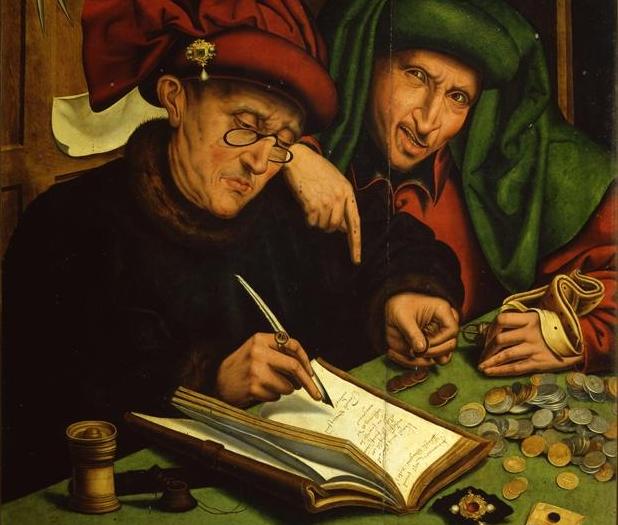






 RSS Feeds:
RSS Feeds: 

